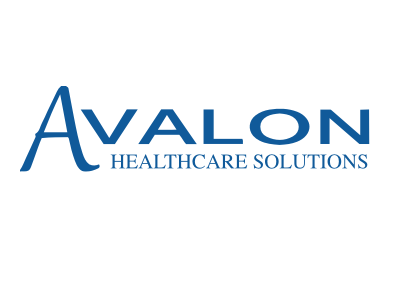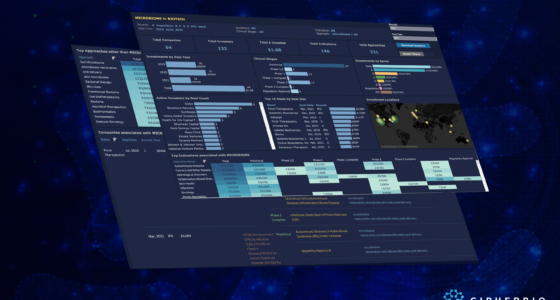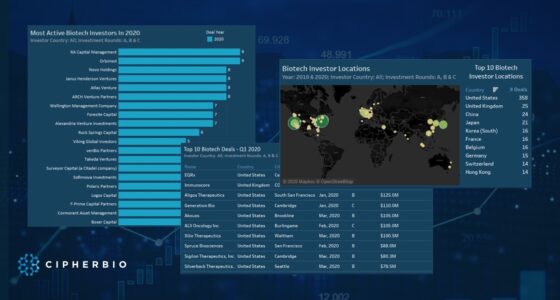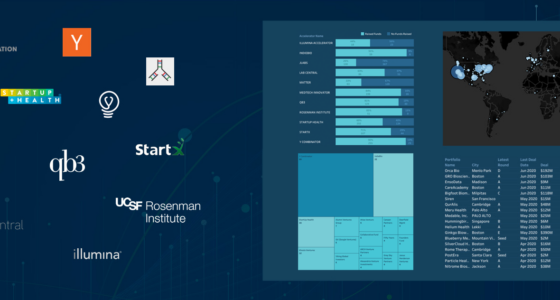
2020 has been a tumultuous year, in which humanity struggled to deal with a burdensome pandemic. There have been many unknowns and high uncertainty. As we approach the end of the year, the response against COVID-19 is beginning to take a clear shape. A nexus of science, technology, and wisely-allocated investment funds seems to have borne fruit. We finally have one or more COVID-19 vaccines that work.
MIT Sloan Professor Andrew Lo, who recently interviewed Moderna’s CEO Stéphane Bancel, said: “Finance and biomedicine are inextricably linked because you need money to develop drugs and devices”. When it comes to developing vaccines, biotech companies need daring investors who are willing to take on the risks involved in such a process. Because this link between finance and biomedicine works, the life science sector has managed to produce more than one viable COVID-19 vaccine in merely a few months – which is a historic record.
CipherBio has been periodically releasing updates (1, 2) on the progress in the fight against COVID-19, and in this update we will highlight the top vaccines that have been approved or pending approval around the world.
Pfizer-BioNTech Vaccine

The German biotech company BioNtech and its U.S. and global counterpart Pfizer had initiated a collaboration on developing a vaccine against COVID-19 earlier this year. A few weeks ago, the two partners announced that their m-RNA based vaccine candidate achieved high efficacy (90%) against the virus.

When the partnering companies first announced on 9 November that they had reached a working vaccine, stock markets took the news very positively. Benchmark indices opened with a large gap to the upside. Investor morale is still high based on the recovery taking place in several financial instruments.
About the COVID-19 Vaccine
The vaccine has been given the name BNT162b2, and is developed based on lipid nanoparticle–formulated nucleoside-modified RNA encoding the severe acute respiratory syndrome coronavirus 2 (SARS-CoV-2) full-length spike protein. Based on the data from the phase 3 trial, the vaccine was 90% effective. The study involved 43,538 participants from the US and abroad.
The vaccine has been approved for emergency use by the FDA for people over 16 years old including healthcare workers. In addition, it has been approved by the Health Sciences Authority in Singapore.
The vaccine is administered on a two-dose schedule, with two to three weeks apart between the two doses to ensure the highest protection possible. It needs to be stored and transported in cold temperatures of minus 70°C (minus 94°F) or lower and is the most demanding from that aspect. Pfizer has designed special thermal shippers whose temperature can be controlled by using dry ice to store and ship the vaccine doses. Pfizer will also track the location and temperature of each vaccine shipment across their predetermined routes constantly by using GPS-enabled thermal sensors to control risk and ensure there are no deviations.
During the joint program, BioNTech has contributed its multiple vaccine candidates while Pfizer has contributed its advanced clinical research and development, regulatory, manufacturing and distribution infrastructure and capabilities.

BioNtech is German biotech company that develops active immunotherapies for the treatment of various diseases, and is based in Mainz. It was founded in 2008 and many investors have backed the company including Fidelity Management and Research Company, Redmile Group, Athena Capital, and others. The company launched its initial public offering in 2019, and the stock has moved in a steady uptrend afterwards. The couple who founded BioNTech, Dr. Ugur Sahin, and Dr. Özlem Türeci, were the ones behind the COVID-19 vaccine. The husband and wife were named People of the Year by the Financial Times newspaper.
Distribution Agreements With Other Countries
Many countries have already made agreements with the two partnering companies to receive doses of the vaccine, and various health authorities have approved it for use. The UK has been the first country in the world to start administering the vaccine to people. The vaccine is expected to be used or has already been used in Bahrain, Canada, Norway, China, Singapore, United States. and the EU.
Moderna Vaccine

In November, Moderna announced that its COVID-19 vaccine is 94.1% effective based on the results of the phase 3 trial. The study included 30,000 participants, 196 of which suffered from COVID-19, of which 30 cases were severe.
Moderna’s CEO called the RNA – on which the vaccine is based – the software of life. It carries important information that can help not only in the development of the COVID-19 vaccine, but many other vaccines as well. Once the genetic sequence is there, it can be used for the development of various drugs. This technique has enabled Moderna to develop a vaccine candidate that reached human trials only 63 days after having received the sequence.
What is unique about mRNA vaccines is that they do not require the injection of the actual virus in the patient’s body. Messenger RNA are molecules that carry instructions to the cells about how to create antibodies, and they can be synthetic rather than real strands of the virus.
Moderna has already received Emergency Use Authorization (EUA) from the FDA, and the application is being processed. An initial analysis conducted by the FDA had already proven the safety and the effectiveness of the vaccine. Moderna has also sought to obtain approval from healthcare authorities in the UK.
About the COVID-19 Vaccine
The vaccine named mRNA-1273 has been developed by Moderna. It is a novel lipid nanoparticle (LNP)-encapsulated mRNA-based vaccine that encodes for a full-length, prefusion stabilized spike (S) protein of SARS-CoV-2. Based on some evidence, the vaccine may be also effective against asymptomatic transmission of the virus, which is an advantage.
Like BioNTech-Pfizer’s vaccine, Moderna’s vaccine is administered in two doses with two to three weeks apart between doses. It also needs to be stored and transported in cold temperatures, but is less demanding than Pfizer-BioNTech’s vaccine – Moderna’s vaccine needs to be stored in temperatures of -20 degrees Celsius (minus 4 degrees Fahrenheit).
When the novel coronavirus started to spread, Moderna had already been working on developing a vaccine for Middle East Respiratory Syndrome (MERS). And when the genome sequencing data of the coronavirus became available, the scientists at Moderna noticed that it was very similar to that of MERS. This prompted them to change priorities and focus on responding to the novel virus. Today, they have developed the most effective vaccine we know of up to this point in the fight against COVID-19.
Moderna has an mRNA platform that can help fast track the development of various drugs for various diseases by relying on messenger RNA and at a lower cost. The platform works very much like an operating system on a computer, which means that it is flexible enough to accommodate various therapeutics for various diseases, based on the vision of the founders and the leaders of the company.
The company was co-founded by Robert Langer and Noubar Afeyan. Stéphane Bancel is currently leading the company as the CEO. The company received backing from various investors including Flagship Pioneering, Alexandria Venture Investments, BB Biotech Ventures, and Merck Ventures before launching its IPO in 2018.

Bob Langer
 Noubar Afeyan
Noubar Afeyan
Stéphane Bancel
Distribution Agreements to Supply the Vaccine
Moderna has already made agreements with various entities to supply its vaccine in several countries including Canada, the U.S., the EU, Japan, Switzerland, Israel, Qatar, and the UK.
Register for a free CipherBio account to find exclusive life science industry insights.
COVID-19 Vaccine by AstraZeneca and the University of Oxford

The British-Swedish company AstraZeneca and the English Oxford University announced in late April that they would be working together on a COVID-19 vaccine. In November, the two partners announced that the vaccine has met its efficacy target.

The template for the vaccine was first designed by Prof Teresa Lambe from Oxford University after she received the genome sequencing data for the virus earlier this year. Prof Sarah Gilbert, who led the team at Oxford University’s Jenner Institute, was the architect of the vaccine. Sarah Gilbert is a professor of vaccinology and has over 10 years of experience in making vaccines that are designed to induce T cell immune response.

Andrew Pollard

Sarah Gilbert

Teresa Lambe
The Oxford scientists had already been vigilant about a pandemic that could come at any time. They worked together with professor Andrew Pollard, the director of the Oxford Vaccine Group, to start a clinical trial. Then, they agreed to cooperate with AstraZeneca to use its large research and manufacturing facilities to scale the process.
About the COVID-19 Vaccine
The vaccine, named ChAdOx1 nCoV-19, is a DNA-based vaccine that codes for the coronavirus spike protein. It was tested on a sample of 23,000 participants including 131 COVID-19 cases, using two different dosing regimens. The first regimen showed an effectiveness rate of 90% while the second one showed an effectiveness rate of 62%, with the average efficacy of the combined dosing regimens being 70%. This meant that the vaccine has met its 50% efficacy target set by the World Health Organization and the FDA. The vaccine has not yet been approved by the UK authorities.
No hospitalization or severe cases were reported in the trial. The vaccine has been genetically modified to make it safer for patients. Moreover, the vaccine does not need to be stored in cold temperatures like those of Pfizer-BioNTech and Moderna, as it is not a mRNA based vaccine. Thus, there should be fewer logistical challenges associated with distributing the vaccine.
AstraZeneca is a Cambridge-based British-Swedish biopharmaceutical company that was founded more than 20 years ago. It offers healthcare products and therapies for oncology, cardiovascular, respiratory and immunology diseases, among others.
Sputnik Vaccine by Gamaleya (Russina State-run Institute)
The vaccine has already been administered to over 200,000 people from high-risk groups. The vaccine is 91.4% effective according to a statement from Gamaleya and the Russian Direct Investment Fund (RDIF). The data is gathered from the phase 3 trial which has been concluded very recently.
If the vaccine receives approval from Dr. Reddy’s Laboratories in India, the country could receive around 100 million doses.
About the COVID-19 Vaccine
The Sputnik V vaccine was the first COVID-19 vaccine to be registered and administered to people in the world. It was developed based on a human adenoviral vector-based platform. The clinical trials involved 40,000 volunteering participants, and took place in the UAE, India, Venezuela, and Belarus. Like some other vaccines, Sputnik V is administered in two doses.
Vaccines for Which the Results Have Not Yet Been Announced
In addition to the vaccines that have already been authorized for use, or whose preliminary results have been released, there remains other vaccines in the development and testing pipelines. Those include vaccines by Novavax, Johnson and Johnson/Janseen, Sanofi/GSK, Sinovac, and Wuhan/Sinofarm.
Treatments and Tests
In addition to vaccines, many treatments and diagnostic tests have been approved by healthcare regulatory authorities such as the FDA. Approved treatments include Remdesivir (owned by Gilead Sciences), casirivimab and imdevimab (to be administered together), and bamlanivimab by Eli Lilly. Approved tests include LabCorp’s Pixel COVID-19 Test Home Collection Kit, RC COVID-19 +Flu RT-PCR Test with the Self-Collection Kit for COVID-19 +Flu by Quest Diagnostics based on a prescription, and BinaxNOW COVID-19 Ag Card Home Test by Abbott (can only be used by patients with a prescription). Treatments and tests are not for general use, but each has its own targeted patient segments.
Final Words
The above vaccines represent a very small sample of the potential vaccines against COVID-19. There are already around 190 vaccines in the development pipeline or in clinical trials around the world.
As the data from the clinical trials becomes available and more vaccines are approved, The WHO-backed Covax facility has the goal of supplying various countries around the world with two billion doses by the end of 2021. The facility has already secured millions of doses from some of the companies, but there are still logistical and administrative challenges to be overcome. We now have a good reason for optimism, despite the potential setback by the new strain of COVID-19.
The COVID-19 Genomics UK (COG-UK) consortium has recently discovered a new variant of the coronavirus. This new variant is characterized by a mutated spike protein which the virus uses to bind itself to the receptors attached to the cells. Arguably, this makes the virus more infectious. Scientists have reason to believe that the vaccines will likely still be effective against the new strain. But even if this is not the case, the vaccines can be tweaked to match the changes in the virus.
This swift and robust response to the vaccine is a sign that the life science sector has evolved greatly since previous pandemics. This evolution did not take place only in the internal capabilities of various organizations, but also in the structure of the sector at large, which has become more agile, flexible, and synergetic. This evolution is enabling us to end 2020 on a positive note.
Join us in our effort to capture the entire life science ecosystem in our database.
We strongly believe that the availability of a high-quality database about the life sciences ecosystem increases sector efficiency and benefits every company raising capital. Thus, if you are an investor or a startup in any of the relevant industries, we would like to extend an invitation to you to join the platform and or subscribe to the CipherBio insight newsletter.
Fill out your digital profile, or update it with your company’s latest news, so that you can be a part of the data set that represents the life science ecosystem.





